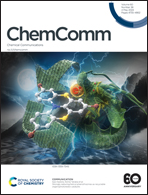Kinetic isotope effect offers selectivity in CO2 reduction†
Abstract
A binuclear Ni complex with N,O donors catalyzes CO2 reduction via its Ni(I) state. The product distribution when H2O is used as a proton source shows similar yields for CO, HCOOH and H2. However, when D2O is used, the product distribution shows a ∼65% selectivity for HCOOH. In situ FTIR indicates that the reaction involves a Ni–COO* and a Ni–CO intermediate. Differences in H/D KIEs on different protonation pathways determine the selectivity of CO2 reduction.

- This article is part of the themed collections: ChemComm 60th Anniversary Roadshow in India and ChemComm 60th Anniversary Board Member Collection


 Please wait while we load your content...
Please wait while we load your content...